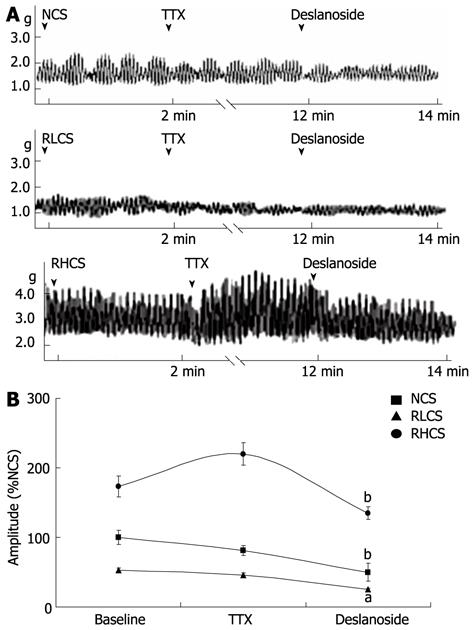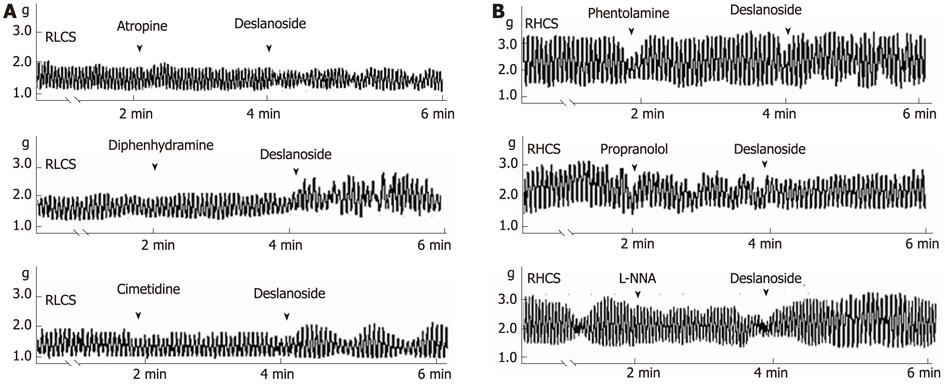Copyright
©2012 Baishideng Publishing Group Co.
World J Gastroenterol. Nov 7, 2012; 18(41): 5889-5896
Published online Nov 7, 2012. doi: 10.3748/wjg.v18.i41.5889
Published online Nov 7, 2012. doi: 10.3748/wjg.v18.i41.5889
Figure 1 Deslanoside-induced bidirectional regulation on the contractility of jejunal smooth muscle fragment.
A: Dose response relationship of caslano side; B, D: Representative traces and statistical analysis of total traces from six independent experiments of deslanoside-induced bidirectional regulation on the contractility of jejunal smooth muscle fragment (JSMF) in eight low contractile states (LCS); C, E: Representative traces and statistical analysis of total traces from six independent experiments of deslanoside-induced bidirectional regulation on the contractility of JSMF in eight high contractile states (HCS). The median value of contractile amplitude of JSMF in normal contractile state is set to 100%, normal contractile state (NCS, control). Low and high contractile states of JSMF are the relative values compared with NCS. Data are expressed as the mean ± SE (%NCS, n = 6); bP < 0.01 vs the control; dP < 0.01 vs contractile amplitude of JSMF in LCS or HCS before deslanoside administration. CP: Constipation-prominent rats; DP: Diarrhea-prominent rats: SNP: Sodium nitroprusside; Ach: Acetylcholine.
Figure 2 Western blotting analysis of the phosphorylation of myosin light chain.
A: Representative images of Western blotting of the phosphorylation of myosin light chain (PMLC) of jejunum; B: Statistical analysis of band intensities of the PMLC in 4 independent experiments in normal contractile state (NCS, control), representative low contractile state (RLCS), and representative high contractile state (RHCS). To correct for loading variations, the result is expressed as a ratio of phosphor-myosin light chain to myosin light chain and NCS control is defined as 100%. Data represent mean ± SE from 4 independent experiments; bP < 0.01 vs RLCS; dP < 0.01 vs RHCS. D: Deslanoside.
Figure 3 Effects of deslanoside on the contractility of jejunal smooth muscle fragment pretreated with tetrodotoxin.
A: Representative traces of deslanoside on the contractility of jejunal smooth muscle fragment (JSMF) pre-treated with tetrodotoxin in normal contractile state (NCS), representative low contractile state (RLCS) and representative high contractile state (RHCS); B: Statistical analysis obtained from independent assays. Other data are the relative values compared with NCS. Data are expressed as the mean ± SE (%NCS, n = 6); aP < 0.05, bP < 0.01 vs contractile amplitude of JSMF after treatment with tetrodotoxin (TTX), (0.1 μmol/L).
Figure 4 Effects of deslanoside on the contractility of jejunal smooth muscle fragment in Ca2+-free conditions.
A: Representative traces of deslanoside (20 μmol/L) on the contractility of jejunal smooth muscle fragment (JSMF) pre-treated with verapamil (0.1 μmol/L) in normal contractile state (NCS), representative low contractile state (RLCS) and representative high contractile state (RHCS); B: Representative traces of deslanoside (5-80 μmol/L) on the contractility of JSMF pre-treated with Ca2+-free Krebs buffer; C, D: Statistical analysis obtained from 6 independent assays in identical assay conditions as (A) and as (B). The mean contractile amplitude of JSMF without drug treatment in NCS is set to a relative value of 100%, other data are expressed as mean ± SE (% NCS, n = 6); bP < 0.01 vs the control group.
Figure 5 Effects of deslanoside on the contractility of jejunal smooth muscle fragment pretreated with receptor antagonist.
A: Effects of deslanoside on the contractility of jejunal smooth muscle fragment (JSMF) pretreated with 10 μmol/L atropine, 10 μmol/L diphenhydramine and 10 μmol/L cimetidine in the representative low contractile state (RLCS), respectively; B: Effects of deslanoside on the contractility of JSMF pretreated with 10 μmol/L phentolamine, 5 μmol/L propranolol and 10 μmol/L L-NG-nitroarginine (L-NNA) in the representative high contractile state (RHCS), respectively.
- Citation: Chen DP, Xiong YJ, Tang ZY, Yao QY, Ye DM, Liu SS, Lin Y. Characteristics of deslanoside-induced modulation on jejunal contractility. World J Gastroenterol 2012; 18(41): 5889-5896
- URL: https://www.wjgnet.com/1007-9327/full/v18/i41/5889.htm
- DOI: https://dx.doi.org/10.3748/wjg.v18.i41.5889













